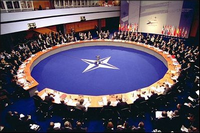NATO officially launched the process of revamping its Strategic Concept this month. As of now, the alliance's next mission statement is "a blank sheet of paper," in the words of outgoing Secretary General Jaap de Hoop Scheffer. But NATO's recent pronouncements and current challenges offer plenty of guidance on how to fill the page.
First, NATO nations must invest more in defense, and they must remember that theirs is, above all, a military alliance. As the secretary general observed, military operations are "NATO's core business."
The U.S. spends about 4 percent of its GDP on defense, but only four other NATO members have mustered the will (.pdf) to meet the alliance's standard of investing just 2 percent. NATO's combat effectiveness is suffering as a consequence: Some NATO members have to hitch a ride with the U.S. Air Force or rent Soviet-era transports to deploy to Afghanistan; they "are not trained in counterinsurgency," in the words of Defense Secretary Robert Gates; and they lack helicopters to move across Afghanistan.

